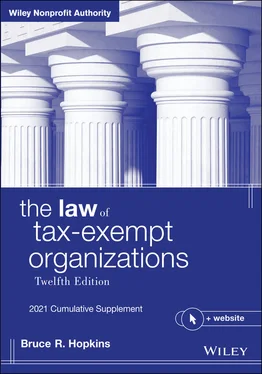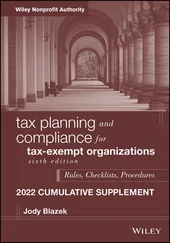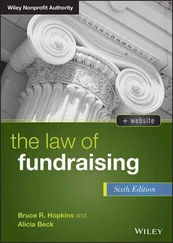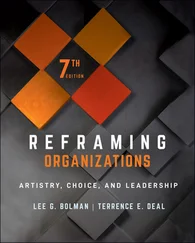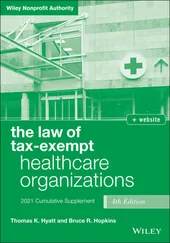Bruce R. Hopkins - The Law of Tax-Exempt Organizations, 2021 Cumulative Supplement
Здесь есть возможность читать онлайн «Bruce R. Hopkins - The Law of Tax-Exempt Organizations, 2021 Cumulative Supplement» — ознакомительный отрывок электронной книги совершенно бесплатно, а после прочтения отрывка купить полную версию. В некоторых случаях можно слушать аудио, скачать через торрент в формате fb2 и присутствует краткое содержание. Жанр: unrecognised, на английском языке. Описание произведения, (предисловие) а так же отзывы посетителей доступны на портале библиотеки ЛибКат.
- Название:The Law of Tax-Exempt Organizations, 2021 Cumulative Supplement
- Автор:
- Жанр:
- Год:неизвестен
- ISBN:нет данных
- Рейтинг книги:5 / 5. Голосов: 1
-
Избранное:Добавить в избранное
- Отзывы:
-
Ваша оценка:
- 100
- 1
- 2
- 3
- 4
- 5
The Law of Tax-Exempt Organizations, 2021 Cumulative Supplement: краткое содержание, описание и аннотация
Предлагаем к чтению аннотацию, описание, краткое содержание или предисловие (зависит от того, что написал сам автор книги «The Law of Tax-Exempt Organizations, 2021 Cumulative Supplement»). Если вы не нашли необходимую информацию о книге — напишите в комментариях, мы постараемся отыскать её.
The Law of Tax-Exempt Organizations, 2021 Cumulative Supplement — читать онлайн ознакомительный отрывок
Ниже представлен текст книги, разбитый по страницам. Система сохранения места последней прочитанной страницы, позволяет с удобством читать онлайн бесплатно книгу «The Law of Tax-Exempt Organizations, 2021 Cumulative Supplement», без необходимости каждый раз заново искать на чём Вы остановились. Поставьте закладку, и сможете в любой момент перейти на страницу, на которой закончили чтение.
Интервал:
Закладка:
p. 5, note 8, second line. Insert following first comma:
Charleston Area Medical Center, Inc., CAMC Health Education and Research Institute, Inc. v. United States, 940 F.3d 1362 (Fed. Cir. 2019); Wichita Center for Graduate Medical Education v. United States, 917 F.3d 1221 (10th Cir. 2019);
p. 5, note 8, third line. Insert and following semi‐colon.
p. 5, note 8, fourth line. Delete text following closing parenthesis and insert period.
CHAPTER TWO Overview of Nonprofit Sector and Tax‐Exempt Organizations
§ 2.1 Profile of Nonprofit Sector
§ 2.2 Organization of IRS(a) IRS in General (b) Tax Exempt and Government Entities Division
§ 2.1 PROFILE OF NONPROFIT SECTOR
p. 22, last paragraph, second line. Insert and types following number.
p. 23. Delete text, including footnotes, following first complete paragraph and insert:
According to data provided by the IRS, as of the close of the federal government's fiscal year 2019, there were 1,718,233 recognized tax‐exempt organizations. 21 Within this group of organizations are 1,365,744 charitable (including educational, scientific, and religious) entities, 79,808 social welfare organizations, 62,700 business leagues, 49,126 social clubs, 45,888 labor and agricultural organizations, 41,756 fraternal beneficiary organizations, 28,575 veterans' organizations, 15,560 domestic fraternal beneficiary societies, 9,406 cemetery companies, 6,050 voluntary employees' beneficiary association, 5,373 benevolent life insurance associations, 4,421 title‐holding corporations, 1,677 state‐chartered credit unions, 671 holding companies for pensions and other entities, 668 instrumentalities of the federal government, 659 mutual insurance companies, 88 supplemental unemployment compensation trusts, and 65 other types of exempt entities. In addition, according to the IRS, there are 39,167 political organizations and 214 religious and apostolic associations.
Other data from the IRS reveals that tax‐exempt organizations filed 1,118,006 annual information returns during that fiscal year. California was the jurisdiction for 113,916 of these filers, followed by Texas (77,149), New York (73,391), Florida (54,886), Pennsylvania (49,699), Ohio (46,819), and Illinois (43,816). The state with the fewest filers was Wyoming (3,637).
During this period, there were 101,880 closures of applications for recognition of tax‐exempt status, with 92,439 applicants approved and 66 disapproved. Entities receiving recognition of exemption included charitable organizations (86,383), social welfare organizations (1,442), business leagues (1,432), and social clubs (1,153). The IRS received 3,070 notices of intent to operate as social welfare organizations, of which 456 were rejected. The agency examined 13,433 returns during this period (including those involving retirement plans, government entities, and tax‐exempt bonds), including those in the Form 990 series (1,335), other annual returns (e.g., Form 990‐PF) (302), employment tax returns (4,495), Forms 990‐T (427), and Forms 4720 (383).
Charitable giving in the United States in 2019 is estimated to have totaled $449.64 billion. 22 Giving by individuals in 2019 amounted to an estimated $309.66 billion; this level of giving constituted 69 percent of all charitable giving for the year. Grantmaking by private foundations is an estimated $75.69 billion (17 percent of total funding). Gifts in the form of charitable bequests in 2019 are estimated to be $43.21 billion (10 percent of total giving). Gifts from corporations in 2019 totaled $21.09 billion (5 percent of total giving for that year).
Contributions to religious organizations in 2019 totaled $128.17 billion (29 percent of all giving that year). Gifts to educational organizations amounted to $64.11 billion (14 percent); to human service entities, $55.99 billion (12 percent); to foundations, $53.51 billion (12 percent); to health care institutions, $41.46 billion (9 percent); to public/society benefit organizations, $37.16 billion (8 percent); to international affairs entities, $28.99 billion (6 percent); to arts, culture, and humanities entities, $21.64 billion (5 percent); and to environment and animals groups, $14.16 billion (3 percent).
Some of the most recent data for the charitable sector 66.1 are for 2015. 66.2 In that year, there were 1,088,447 registered public charities, of which 314,744 were sufficiently large to file Form 990. 66.3 These organizations reported $3.8 trillion in total assets ($2.3 trillion in net assets) and total revenue of $2 trillion (approximately 11 percent of gross domestic product). Most of the Form 990 filers were relatively small (assets of less than $500,000) or medium‐sized (assets of $500,000 up to $10 million) charities (41.2 percent and 47.2 percent, respectively). The larger organizations, those with at least $10 million in assets, were 11.6 percent of Form 990 filers; 93.1 percent of assets were held by, 87.1 percent of revenues were received by, and 71.5 percent of contributions were made to these entities. The primary source of revenue for these organizations was program service revenue (73.1 percent), with charitable contributions accounting for a much smaller amount (12.9 percent).
p. 24. Delete text, including footnotes.
p. 25. Delete carryover paragraph and following two paragraphs, including footnotes.
§ 2.2 ORGANIZATION OF IRS
(a) IRS in General
p. 26, note 74, second line. Delete this section and insert infra notes 75–84.
p. 27, second complete paragraph, sixth line. Delete Large and Mid‐Size Business and insert Large Business and International.
p. 27. Insert following third complete paragraph, before heading:
Congress in 2019 issued new directives to the Department of the Treasury and the IRS concerning the structure and functioning of the IRS. 84.1 By September 30, 2020, Treasury must submit to Congress a comprehensive written plan to redesign the organization of the IRS. This plan must (1) ensure successful implementation of the priorities specified by Congress in the Act; (2) prioritize taxpayer services to ensure that all taxpayers “easily and readily” receive the assistance they need; (3) streamline the structure of the IRS, including minimizing duplication of services and responsibilities within it; (4) best position the IRS to combat cybersecurity and other threats to the agency; and (5) address whether the Criminal Investigation Division of the IRS should report directly to the Commissioner of Internal Revenue. 84.2
Within one year of issuance of these directives, Treasury is to submit to Congress a written comprehensive customer service strategy for the IRS. This strategy must include a plan to provide assistance to taxpayers that is secure, designed to meet reasonable taxpayer expectations, and adopts appropriate best practices of customer service provided in the private sector, including online services, telephone call‐back services, and training of employees providing customer services. This strategy must also include (1) a thorough assessment of the services that the IRS can co‐locate with other federal services or offer as self‐service options; and (2) proposals to improve IRS customer service in the short term (current and following fiscal year), medium term (3–5 fiscal years), and long term (about 10 fiscal years). 84.3
In 2019, Congress created the position in the IRS of a Chief Information Officer, to be appointed by the Commissioner of Internal Revenue. This CIO is to develop, implement, and maintain information technology for the IRS. The CIO is also required to develop and implement a multiyear strategic plan for the information technology needs of the IRS. 84.4
Читать дальшеИнтервал:
Закладка:
Похожие книги на «The Law of Tax-Exempt Organizations, 2021 Cumulative Supplement»
Представляем Вашему вниманию похожие книги на «The Law of Tax-Exempt Organizations, 2021 Cumulative Supplement» списком для выбора. Мы отобрали схожую по названию и смыслу литературу в надежде предоставить читателям больше вариантов отыскать новые, интересные, ещё непрочитанные произведения.
Обсуждение, отзывы о книге «The Law of Tax-Exempt Organizations, 2021 Cumulative Supplement» и просто собственные мнения читателей. Оставьте ваши комментарии, напишите, что Вы думаете о произведении, его смысле или главных героях. Укажите что конкретно понравилось, а что нет, и почему Вы так считаете.
